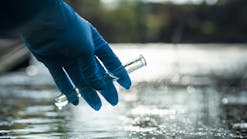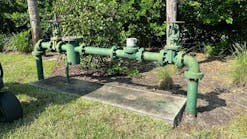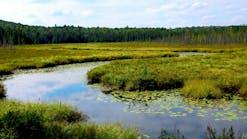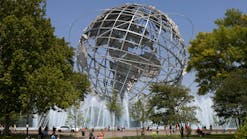Golf courses are large, open, green spaces that are very visible in their communities. Unfortunately, golf courses require a lot of inputs to maintain their condition. Depending on the quality of the golf course, some need more inputs than others. One of the needed inputs to maintain a healthy playing surface is, of course, water. Golf courses are large users of water, but also very visible users of water due to the “green” of the turf. The large sprinklers that they employ to irrigate with are easily visible from both inside and outside the golf course. However, you might be surprised to know that when compared to other types of irrigation, golf courses are, in general, the most efficient users of water.
There are approximately 15,000 golf courses in the United States. Over the last five years, the number of courses has been declining at an approximate rate of about 400 18-hole equivalents per year. New golf construction, at least in the United States, has been almost at a standstill, but some new courses have been completed in 2014 with more scheduled for 2015. The 15,000 existing golf courses water an average of 80 acres with some type of irrigation, be it hoses, quick coupling valves with sprinklers, or automatic sprinklers. In total, golf courses in the United States use approximately 0.5% of daily total water consumption of all uses per day, or 2.08 billion gallons of water. According the Golf Course Superintendents Association of America (GCSAA), golf course water use varies considerably based on the geographical area where the course is located. In the Southwest, courses use on average 1,303,392 gallons per year per acre, while an 18-hole course in the Northeast uses only 260,678 gallons of water per acre annually.
Golf course irrigation systems can be supplied water from many different sources, including potable, effluent, surface (ponds, lakes, rivers, and streams), and groundwater. According to GCSAA, golf course water sources break down as follows:
- Surface: 52%
- Groundwater (Wells): 46%
- Potable (Municipal): 14%
- Effluent: 12%
Many golf courses use a combination of sources, hence the total percentage in the list is over 100%. For example, although water may not be pumped directly from a well into the irrigation system due to the large flow required by the irrigation system, the well is instead used to fill an irrigation pond. The pond will then have a large pump station to provide the larger flow required to irrigate the golf course in an appropriate time period.
An increasing number of golf courses utilize effluent/recycled water to irrigate their turf, if it is available to their facility. There are many advantages to using effluent water to irrigate, including lower supply costs and reduced fertilizer and nutrient use. The downside is that the salts associated with the effluent water need to be carefully managed to prevent damage, as many turf species are susceptible to high salt concentrations. With effluent supplied systems, additional water is used to leach or flush out the salts from the soil profile. Some areas such as the Southeast (24% of courses) and the Southwest (37% of courses) are proactive when it comes to using effluent water, while others like the North Central and Northeast (3% of courses) may not even allow it to be used as an irrigation source.
Costs for water to irrigate a golf course vary regionally, with an average 18-hole annual water cost in the Southwest being $107,800 and in the North Central area of the United States only $4,700.00. Many courses pay nothing for their water–only the cost to pump it.
Irrigation sprinklers used for golf courses are much different than sprinklers used for landscape irrigation. A golf course can have between 500 and 5,000 sprinklers, or even more installed throughout an 18-hole facility. A golf irrigation sprinkler uses 18–45 gallons per minute throwing 50–90 feet with as many as 100 sprinklers operating at the same time. Economics of pipe sizing dictate that the 100 sprinklers operating would be spread out over the 18 holes and not concentrated in one area of the course. The amount of time to water a golf course is ideally limited to less than 8 hours. This allows irrigation to take place when there is less wind and evaporation of the water being applied. By watering the golf course over a short time period inefficiencies are reduced, and it does not interfere with other activities such as mowing and play. Golf course irrigation sprinklers operate at high pressures–65 to 100 psi at the base of the sprinkler, requiring 110 psi plus at the water supply. The pressure may be created by a pump in the water source or boosted if a pressurized potable or effluent source is being used.
Many golf courses also have landscape systems for irrigation of areas around the clubhouse, pool, tennis courts, and entrance areas. These systems may or may not be on the same water source as the golf course. Many times, the landscape irrigation may be on a potable source and the golf course irrigation system on a different type of water supply.
Irrigation control systems for golf courses are very sophisticated software programs that operate from a computer. The software operates off a database that includes all of the information about each sprinkler, percent slope, soil type, and the ability to cycle water on, and then let it soak in. Each golf course sprinkler is individually controlled so it can be accurately timed. This allows the area that the sprinkler covers to be precisely watered. Each individual sprinkler is pressure-regulated so that the sprinkler receives its intended pressure regardless of elevation change or distance from the water supply. Golf course irrigation sprinklers are the most uniform applicators of water of any sprinkler manufactured. Distribution uniformities are commonly over 80% and scheduling coefficients in the 1.1–1.15 range, so little additional water is needed due to inefficiencies.
Many golf courses have weather stations located on their property to provide real-time evapotranspiration data. The data is automatically accessed by the computer control system and can, if desired, automatically adjust the sprinkler run times. Unlike landscape irrigation controllers with a water budgeting feature, golf irrigation systems have the ability to adjust run times based on the type of area being irrigated (green, tee, fairway, rough) per field controller and per sprinkler. These various abilities to adjust the run times allow the irrigation system operator to tweak each individual sprinkler application to minimize water use.
Golf course superintendents are highly educated individuals. They are not only educated and trained in the operation of the specific irrigation control system installed at their facilities, but also in soils and turf grass. Their educational background and experience, along with the use of weather stations and soil moisture sensors, allow them to use the tools available in the control software to fine-tune the irrigation systems to only provide the amount of water needed to each area of the golf course through individual sprinklers or a group of sprinklers. This minimizes the amount of water applied and provides firm and fast golfing conditions. Golf course irrigation systems are normally in the 80% efficiency range, the highest achievable efficiency with overhead irrigation.
The general public looks at the large green expanse of a golf course and the amount of water it uses and assumes that the golf course is wasting water. However, the sophisticated irrigation control systems and highly uniform sprinklers used, as well as the education of the golf course superintendent and the additional tools they use (such as weather stations and soil moisture sensors) result in highly efficient irrigation systems. Highly efficient irrigation systems result in using as little water as needed, whether it is a potable or another water source. Golf course irrigation water use should never be judged based on the number of sprinklers it has, as sprinkler count has nothing to do with how much water a golf course is using. Less sprinklers used does not mean less water used. The more control there is over the water distribution, the less water will be used. In most cases, this will dictate having more sprinklers using sophisticated controls, so the water is also only applied when needed.






